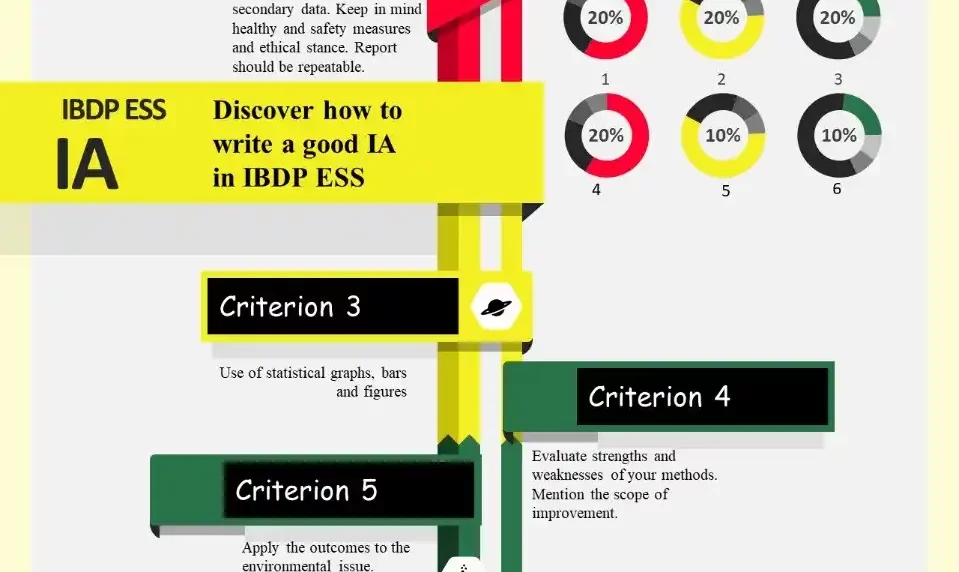IBDP ESS IA
In this blog, you will discover how to write a good IBDP ESS IA. It counts for 25% of your total score, which is quite a big portion of your score! It’s a report of 1500-2250 words. Students enjoy ESS internal assessment because it provides a greater bandwidth to connect challenges of the environment with humans. The idea is to find the extent to which some specific human activity has impacted the environment locally or a specific geographical area. You may find ESS IA samples here.
There are 6 IA criteria.
ESS IA Criterion 1- Identifying the context CXT (6 marks- 20% weightage)
You have to be pretty observant in exploring a local and global environment issue from the ESS topics in your syllabus. As and how you go through the topics, keep on highlighting the different environmental issues you encounter. Select one of your areas of interest and which has a good scope of research. Now, connect your environmental issue with a research question (RQ). Your RQ must be relevant, coherent, and focused.
What’s relevant?
The RQ which connects to an environmental issue is the relevant one. It is not easy to frame a good scoring ESS IA research question however narrowing it down to human activity that has caused something can be a good idea. It is strongly recommended that students must choose a limited geographical location to analyze and evaluate the impact.
How to make it coherent?
How you phrase it matters. Keep it lucid and precise. Avoid being verbose. This means your research question must not be vague, should be precise yet narrowed down to make examiners understand the purpose.
How to be focused?
Explicate your RQ through a precise detailing and analysis of your effector and response variables in the system. The moment you get the variables; causation or correlation relation can easily be chalked out. That’s it! What is meant by specific detailing is a vivid example of the location or species involved in the RQ.
ESS IA Criterion 2- Planning PLA (6 marks- 20% weightage)
This criterion calls for assessing the ways to collect. Data can be primary and/or secondary. You need to substantiate the use of data.
Primary data can range from surveys, interviews, questionnaires, fieldwork, field manipulation experiment, modeling (physical, simulation).
Write a sequential process of investigation, keeping in mind the health and safety measures, accounting for possible hazards and risks, and abiding by the ethical considerations and sensitive treatment with animals, ecosystem, and people.
Your planning phase necessitates preparing a report which is ‘repeatable’.
What’s repeatable?
You need to design a repeatable method pertinent to your RQ that allows for sufficient relevant data. Remember, this means that your sampling is free from under coverage or voluntary bias. It should be randomized based on a reasonably sufficient size leading to a valid conclusion on the reliable average, which necessarily connotes its replication for another environment or society.
ESS IA Criterion 3- Results, analysis, and conclusion RAC (6 marks- 20% weightage)
Statistical graphs, charts, and diagrams represent your qualitative or quantitative data. This criterion evaluates how well you have collected, organized, analyzed, and interpreted your data with a display of relevant patterns, trends, and relations.
ESS IA Criterion 4- Discussion and evaluation DEV (6 marks- 20% weightage)
Your conclusion is the extraction of your whole analysis. Remember to evaluate your conclusion in the context of the environmental issue. Critique your method highlighting the strengths and the weaknesses. Also, focus on the scope of improvement.
ESS IA checklist
How well is my RQ connected with the environmental issue?
Have I established a relation between my variables?
Can I back up my experiment with statistical significance?
Is my conclusion linking back to my environmental issue?
ESS IA Criterion 5- Applications APP (3 marks- 10% weightage)
Apply the outcomes of your investigation to the broad environmental issue identified. In order to reach the highest mark band, student’s work must justify the solution and judge the strengths and weakness of the solution.
ESS IA Criterion 6- Communication CAM (3 marks- 10% weightage)
Your report should be presented well with an organized structure emphasizing focus, process, and outcomes. Be specific to mention all the sites you have researched in your Bibliography.
For complete IBDP ESS syllabus, you may click here.
Also, please find other interesting read about online Tutoring, IBDP Biology and IBDP Psychology







